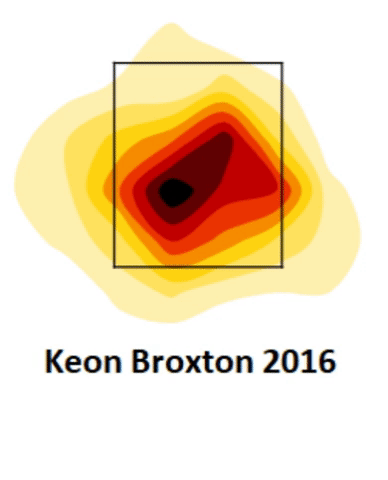The Endless Possibilities of Franchy Cordero
At the end of April, Mike Petriello wrote on the most interesting rookie you need to know more about, Padres outfielder Franchy Cordero. The way Cordero hits the ball, paired with how he runs and can defend, make him more than intriguing. However, Petriello detailed that the margin of error within Cordero’s game could turn him into just about anything — be it Keon Broxton or Aaron Judge.
The two potential comps couldn’t possibly represent further opposite ends of the spectrum. Broxton was demoted to the minors last season and Judge was a Rookie of the Year winner and MVP candidate. So where will Cordero end up shading himself within that vast spectrum? Consider those three players in their first extended stint in the Majors.

Can you tell who’s who?
Players A and C are Judge and Broxton in 2016. The two had largely similar plate discipline. The biggest differences came in Broxton’s reluctance to chase out of the zone, which fueled a lower strikeout total and a high amount of walks. But in between them, as player B, is Cordero. He swung more, chased nearly as much as Judge, made the least contact in the zone by a big margin, and whiffed way more than any of the three. While these are just descriptive numbers — things we can look at after the fact — it’s easy to see how Cordero approaches the batter’s box similar as these two other guys whose difference in success could fill the Grand Canyon.
The real interesting part comes in looking at their plate discipline after their first extended stint in the Majors. It gives us a sense of how each player bought into their skill set, possibly based on the success they did or didn’t have in their debuts.

Notice anything? Broxton went one way in the season after his debut, while Judge and Cordero have gone the other, more productive way. Broxton simply did the things you don’t want a player to do. He reached out of the zone more, made less contact doing it, and created fewer free passes for himself. Judge reached out of the zone less, made more contact, and shrunk his K-BB rate to Rick Moranis levels. It’s funny how one decision can impact so many results.

So far, Cordero’s second extended stint in the Majors has mimicked Judge’s. He’s trending in all the same ways and generating monster power while he’s at it. Petriello noted how he’s part of the roughly one percent of hitters in the entire league to have hit a ball 115+ mph in 2018. That single data point alone is enough to project a pretty positive profile. What he’s really doing to generate that kind of exit velocity, though, is optimizing his mechanics with his contact point. It’s even more impressive when you combine it with how he hits homers. Since Statcast went live in 2015, the greatest average home run distance from any single player is Carlos Gonzalez, at 421 feet. Giancarlo Stanton is second at 420 feet. Cordero has averaged 438 feet per bomb after six home runs so far in 2018.
The Padres seem to believe that Cordero isn’t a finished product just yet, but that he’s good enough to learn on the job. The biggest truth to that is probably most easily visible in his free swinging ways. When he came up last year, he struck out in more than 44% of his plate appearances while drawing a walk in only six percent. But this year, his improved discipline at the dish has resulted in a jump in walks of four percent and an 11% decrease in whiffs. He’s not quite stepping up to Aaron Judge levels, but he’s demonstrating that he’s learned two things. One is that he can let tempting pitches out of the zone go because the contact he does make is strong enough to wait for. The other is that just because a pitch is in the zone doesn’t mean he has to swing. In this sense, it’s like a pitcher sequencing his stuff. By letting pitches go that don’t necessarily play into his strengths, Cordero is giving himself more opportunities to meet the ones that do.
If you’ve been wondering about sample sizes for all the examples above, that’s fair. Most of them are relatively small, potentially opening them to scrutiny because they don’t provide us the stability we crave when evaluating players. But that doesn’t mean they’re useless. In this context, they act in two ways: as indicators of aggression in each of Judge, Broxton, and Cordero; and what they’ve each learned once they had a chance to stay up in the Majors.
Franchy Cordero has proven to be more than intriguing, and he’s found himself in a unique situation that many clubs wouldn’t likely provide a young player. But the Padres are in a unique spot, too, and Cordero, unheralded as he may be so far, may be critical in helping to elevate them in the standings as time moves on.
—
Plate discipline data from FanGraphs. Heat maps from Baseball Savant; gif made with Giphy.
Tim Jackson is a writer and educator who loves pitching duels. Find him and all his baseball thoughts online at timjacksonwrites.com/baseball and @TimCertain.
thanks for this article! I’ve been standing at the top of the mountains shouting Franchy’s name since the off season. It’s good to see an article dedicated to him finally make it’s debut here. I was very impressed with his 12 game onbase streak, which just ended last night. His O-Swing% has gone down from 38% in 2017 to 27.6% this year while his contact % has gone up from 59.3% in 2017 to 65.2% so far in 2018, all while sporting a .228 ISO and all the statcast goodness too! Needless to say I’m happy he’s on my dynasty.